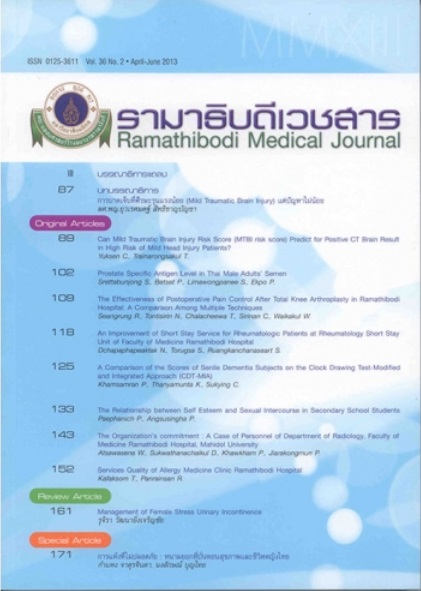Can Mild Traumatic Brain Injury Risk Score (MTBI risk score) Predict for Positive CT Brain Result in High Risk of Mild Head Injury Patients?
Keywords:
Mild TBI, Brain CT scanAbstract
Backgrounds: The most common presentation of traumatic brain injury in Emergency Department is mild traumatic brain injury (Mild TBI). Brain CT scan is not necessary in all mild TBI patient.
Objective: To investigate the impact of risk factors involving brain abnormalities on CT scan, and document the effectiveness of MTBI risk score to used in mild TBI.
Methodology: Retrospective data from medical records and divided patients into 2 groups; those with abnomal brain CT results and those without brain CT abnormalities. Then, analyzing the risk factors and conditions of these two groups in order to indicate the risk factors related to an abnormality in the brain.
Result: Total numbers of patients were 350 persons, comprise of 89 persons with abnormal brain CT (25.43%) and 261 persons without brain abnormalitkes (74.57%). The result showed only 13 risk factors that have the important effect on brain abnormalities. Throughout the multivariate analysis, there was a clearly result indicate that only 7 risk factors significantly caused the abnormalities of brain. Form these 7 risk factors, we formulated for MTBI risk score. Each risk factors (Clinical sign of skull fracture, multi-system trauma with GCS 13-14, history of loss of conciousness, dangerous mechanism, post traumatic amnesia, GCS 13-14) was given 1 point except for focal neurological signs that given 2 points. Patient with MTBI risk score greater or equal to 1 point suggested to be evaluated by CT scan. The sensitivity and specificity of MTBI risk score were 92.13% and 34.10%.
Conclusion: MTBI risk score may be used in mild TBI patients to indication for brain CT scan.
References
Several injury due to transport accident 2007. Bureau of Epidemiology Department of Disease Control Ministry of Public Health; 2007.
Teasdale G, Jennett B. Assessment of coma and impaired consciousness. A practical scale. Lancet. 1974;2:81-4.
Rimel RW, Giordani B, Boll TJ, Jane JA. Disability caused by minor head injury. Neurosurg. 1981;9:221-8.
Levin HS. Outcome from mild head injury. In Narayan RK, Wilberger JE, Povlishock JT, editors. Neurotrauma. New York: McGraw-Hill, 1996:755-65.
Gabriel EM, Turner DA. Minor head injury: management and outcome. In: Wilkins RH, Rengachary SS. Neurosurgery. 2nd editor. New York: McGraw-Hill, 1996;2723-6.
Galbraith S. Misdiagnosis and delayed diagnosis in traumatic intracranial haematoma. BMJ. 1976;1:1438-49.
Jagoda AS, Bazarian JJ, Bruns JJ Jr, et al. Clinical policy: neuroimaging and decision making in adult mild traumatic brain injury in the acute setting. Ann Emerg Med. 2002;40:231-49.
Laupacis A, Sekar N, Stiell IG. Clinical prediction rules: a review and suggested modifications of methodological standards. JAMA. 1997;277:488-94.
Graham ID, Stiell IG, Laupacis A, O'Connor AM, Wells GA. Emergency physicians' attitude toward the use of clinical decision rules for radiography. Acad Emerg Med. 1998;5:134-40.
Stiell IG, Wells GA, Vandemheen K, et al. The Canadian CT Head Rule for patients with minor head injury. Lancet. 2001;357:1391-6.
Haydel MJ, Preston CA, Mils TJ, Luber S, Blaudeau E, DeBlieux PM. Indication for computed tomography in patient with minor head injury. N Engl J Med. 2000;343:100-5.
Marion S, Diederik WJ, Ewout WS, et al. Predicting intracranial traumatic findings on computed tomography in patient with minor head injury: the CHIP prediction rule. Ann Intern Med. 2007;146:397-405.
Ibanez J, Arikan F, Pedraza S, et al. Reliability of clinical guidelines in the detection of patients at risk following mild head injury: results of a prospective study. J Neurosurg. 2004;100:825-34.
Stiell IG, Wells GA, Vandemheen K, et al. The Canadian CT head rule for patient with minor head injury: rationale, objectives and methodology for phase I (derivative). Ann Emerg Med. 2001;38:160-9.
Marshall LF, Toole BM, Bowers SA. The National Traumatic Coma Data Bank. Part 2: Patient who talk and deteriorate: Implications for treatment. J Neurosurg. 1983;59:285-8.
Reilly PL, Graham DI, Adams JH, Jennett B. Patients with head injury who talk and die. Lancet. 1975;2:375-7.
Rockswold GL, Pheley PJ. Patient who talk and deteriorate. Ann Emerg Med. 1993;22:1004-7.
Rockswold GL, Leonard PR, Nagib MG. Analysis of management in thirty-three closed head injury patients who "talked and deteriorate". Neurosurgery. 1987;21:51-5.
Gomez PA, Labato RD, Ortega JM, De La Cruz J. Mild head injury: Differences in prognosis among patients with a Glasgow Coma Scale score of 13 to 15 and analysis of factor associated with abnormal CT findings. Br J Neurosurg. 1996;10:453-60.
Riesgo P, Piquer J, Botella C, Orozco M, Navarro J. Delayed extradural hematoma after mild head injury: report of three cases. Surg Neurol. 1997;48:226-31.
Jennett B, Teasdale G. Manahement of head injury. Philadelphia: F.A.Davis. 1981;2.
Chirawatkul A. Statistics for health science research. Bangkok: Withayapat Co.Ltd. 2009:23-40.













